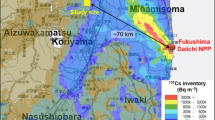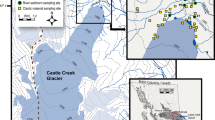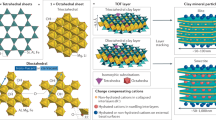Abstract
A MAJOR concern to environmentalists, health physicists and radioecologists is the fate of 137Cs released to the environment from existing light-water power stations (estimated annual discharge of 137Cs as liquid effluent exceeds 2.0 Ci per yr per power station) and future nuclear fuel reprocessing facilities1. Its long half life (30 yr) and its ability to be readily assimilated into body tissues make it potentially one of the most hazardous radionuclides for man. Numerous investigations into the fate of 137Cs in terrestrial environments have revealed that soils exhibit a marked capacity to retain 137Cs; thus soils act as a ‘sink’ for 137Cs released to the environment2,3, and sediments retain 137Cs in a similar fashion in aquatic environments4,5.
This is a preview of subscription content, access via your institution
Access options
Subscribe to this journal
Receive 51 print issues and online access
$199.00 per year
only $3.90 per issue
Buy this article
- Purchase on Springer Link
- Instant access to full article PDF
Prices may be subject to local taxes which are calculated during checkout
Similar content being viewed by others
References
Booth, R. S., ORNL-TM-3801 (1975).
Fredricksson, L., et al., Int. Conf. Peaceful Uses Atomic Energy, II. Geneva, 18, 449–470 (1958).
Schultz, R. K., Overstreet, R., and Barshad, I., Soil Sci., 89, 16–27 (1960).
Lomenick, T. F., and Tamura, T., Soil Sci. Soc. Am. Proc., 29, 383–387 (1965).
Nishita, H., Kowalewsky, B. W., Steen, A. J., and Larson, K. H., Soil Sci., 81, 317–326 (1956).
Tamura, T., and Jacobs, D. G., Hlth Phys., 2, 391–398 (1960).
Sawhney, B. L., Clays Clay Min., 18, 47–52 (1970).
Fredricksson, L., Lantbr-Högsk Annlr, 36, 41–60, 68–89 (1970).
Marei, A. N., Barkhudarov, R. M., Novikova, N. J., and Petukhova, E. V., Hlth Phys., 22, 9–15 (1972).
Francis, C. W., Bonner, W. P., and Tamura, T., Soil Sci. Soc. Am. Proc., 36, 366–372 (1972).
Brisbin, I. L., Jr, et al., Hlth Phys., 27, 19–27 (1974).
Lee, S. Y., Jackson, M. L., and Brown, J. L., Clays Clay Min., 23, 125–129 (1975).
Eyman, L. D., and Kitchings, J. T., Verh. Int. Verein. Limnol. (in the press).
Author information
Authors and Affiliations
Rights and permissions
About this article
Cite this article
FRANCIS, C., BRINKLEY, F. Preferential adsorption of 137Cs to micaceous minerals in contaminated freshwater sediment. Nature 260, 511–513 (1976). https://doi.org/10.1038/260511a0
Received:
Accepted:
Issue Date:
DOI: https://doi.org/10.1038/260511a0
This article is cited by
-
Dynamics of radiocesium in an irrigation reservoir managed at low water level from the perspective of inflow and outflow water quality under non-flood conditions
Paddy and Water Environment (2022)
-
A comprehensive study on sedimentation rate and sediment age of Satopanth Tal Garhwal Himalaya, using 210Pb and 137Cs techniques
Journal of Radioanalytical and Nuclear Chemistry (2021)
-
Use of 137Cs and 210Pbex fallout radionuclides for spatial soil erosion and redistribution assessment on steeply sloping agricultural highlands
Journal of Mountain Science (2021)
-
Reproduction of sediment deposition and prediction of 137Cs concentration in the major urban rivers of Tokyo
Scientific Reports (2020)
-
Effects of river infrastructures on the floodplain sedimentary environment in the Rhône River
Journal of Soils and Sediments (2020)
Comments
By submitting a comment you agree to abide by our Terms and Community Guidelines. If you find something abusive or that does not comply with our terms or guidelines please flag it as inappropriate.



